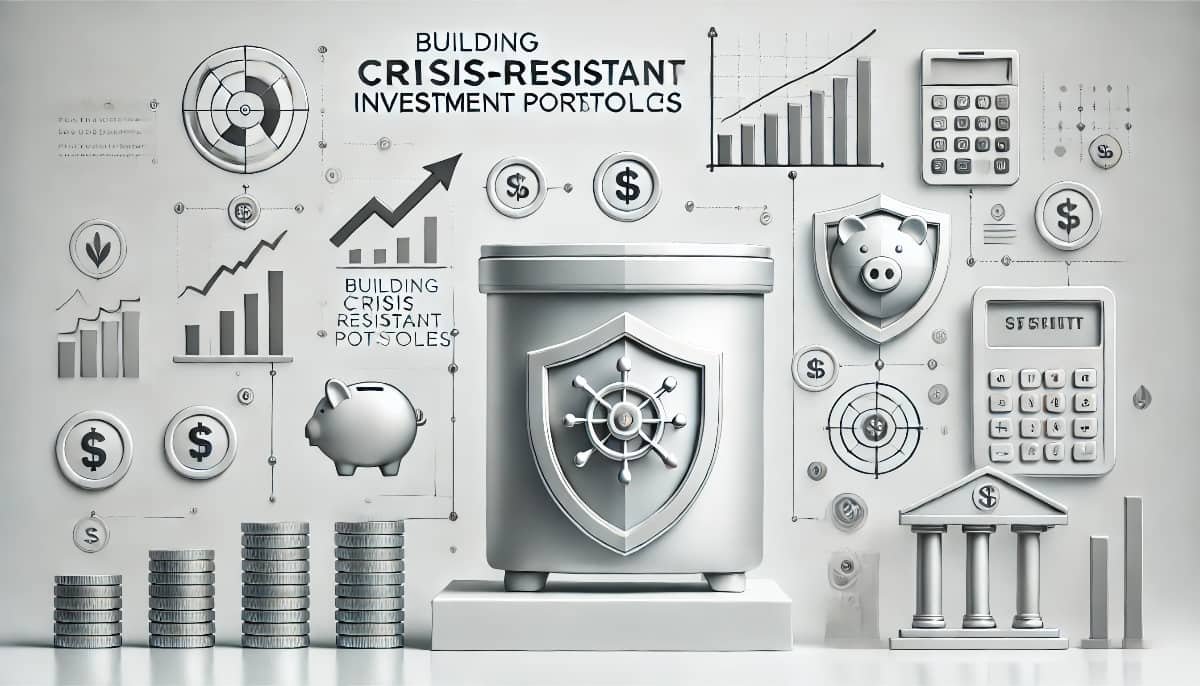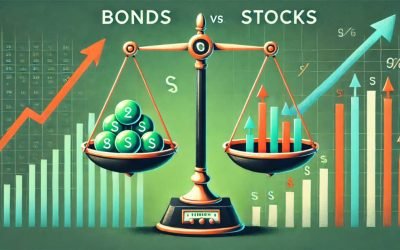Understanding the Foundations of Crisis-Resistant Investment Portfolios
In an ever-changing global economy, the ability to build a crisis-resistant investment portfolio is more crucial than ever. Economic downturns, geopolitical tensions, and unexpected global events can wreak havoc on financial markets, leaving unprepared investors vulnerable to significant losses. This article delves into the strategies and principles necessary to construct a robust investment portfolio capable of weathering financial storms.
How to build simple portfolio video:
What is a Crisis-Resistant Investment Portfolio?
A crisis-resistant investment portfolio is designed to minimise losses and maintain stability during periods of economic uncertainty. Unlike traditional portfolios, which may focus primarily on maximising returns, a crisis-resistant portfolio prioritises risk management and diversification. The goal is to create a balanced mix of assets that can withstand market volatility and provide steady returns over the long term.
Key Principles of Building a Crisis-Resistant Portfolio
To build a crisis-resistant investment portfolio, investors should adhere to several key principles:
- Diversification: Spread investments across various asset classes to reduce risk.
- Asset Allocation: Allocate assets based on risk tolerance and investment goals.
- Quality Investments: Focus on high-quality, resilient assets.
- Regular Rebalancing: Adjust the portfolio periodically to maintain the desired asset allocation.
- Long-Term Perspective: Maintain a long-term investment horizon to ride out market fluctuations.
Diversification: The Cornerstone of Risk Management
Diversification is the practice of spreading investments across different asset classes, sectors, and geographical regions to reduce risk. By not putting all your eggs in one basket, you can mitigate the impact of a downturn in any single market or sector.
Asset Classes
Investing in a variety of asset classes can help protect your portfolio from market volatility. Common asset classes include:
- Equities: Stocks of companies across different industries and regions.
- Bonds: Government and corporate bonds with varying maturities and credit ratings.
- Real Estate: Property investments, including residential, commercial, and industrial real estate.
- Commodities: Physical assets such as gold, silver, oil, and agricultural products.
- Cash and Cash Equivalents: Short-term, highly liquid investments like money market funds and Treasury bills.
Sectors and Industries
Diversifying across different sectors and industries can further reduce risk. For example, investing in technology, healthcare, consumer goods, and utilities can provide a buffer against sector-specific downturns.
Geographical Diversification
Investing in different geographical regions can protect your portfolio from country-specific risks. Consider allocating investments to developed markets (e.g., the United States, Europe) and emerging markets (e.g., China, India) to achieve a balanced global exposure.
Asset Allocation: Balancing Risk and Reward
Asset allocation involves distributing investments among different asset classes based on your risk tolerance, investment goals, and time horizon. A well-balanced asset allocation can help manage risk and achieve desired returns.
Risk Tolerance
Your risk tolerance is your ability and willingness to endure market volatility. It is influenced by factors such as age, financial situation, and investment experience. Generally, younger investors with a longer time horizon can afford to take on more risk, while older investors nearing retirement may prefer a more conservative approach.
Investment Goals
Clearly defined investment goals can guide your asset allocation strategy. Whether you are saving for retirement, a child’s education, or a major purchase, your goals will determine the appropriate mix of assets.
Time Horizon
Your time horizon is the length of time you expect to hold your investments before needing to access the funds. A longer time horizon allows for a higher allocation to riskier assets, while a shorter time horizon may necessitate a more conservative approach.
Quality Investments: Focus on Resilient Assets
Investing in high-quality, resilient assets can enhance the stability of your portfolio during times of crisis. Look for investments with strong fundamentals, such as solid financials, competitive advantages, and experienced management teams.
Blue-Chip Stocks
Blue-chip stocks are shares of large, well-established companies with a history of stable earnings and dividends. These companies are often leaders in their industries and have the financial strength to withstand economic downturns.
Investment-Grade Bonds
Investment-grade bonds are issued by governments and corporations with high credit ratings. These bonds are considered lower risk and provide a reliable source of income, making them a valuable component of a crisis-resistant portfolio.
Defensive Sectors
Defensive sectors, such as utilities, healthcare, and consumer staples, tend to perform well during economic downturns. These sectors provide essential goods and services that remain in demand regardless of economic conditions.
Regular Rebalancing: Maintaining the Desired Asset Allocation
Regularly rebalancing your portfolio ensures that it remains aligned with your risk tolerance and investment goals. Over time, market fluctuations can cause your asset allocation to drift from its target. Rebalancing involves selling overperforming assets and buying underperforming ones to restore the desired allocation.
Frequency of Rebalancing
The frequency of rebalancing depends on your investment strategy and market conditions. Some investors rebalance annually, while others may do so quarterly or semi-annually. The key is to establish a consistent rebalancing schedule that suits your needs.
Rebalancing Strategies
There are several rebalancing strategies to consider:
- Calendar Rebalancing: Rebalance at predetermined intervals, such as annually or quarterly.
- Threshold Rebalancing: Rebalance when an asset class deviates from its target allocation by a certain percentage.
- Combination Rebalancing: Use a combination of calendar and threshold rebalancing to maintain flexibility.
Long-Term Perspective: Riding Out Market Fluctuations
Maintaining a long-term perspective is essential for building a crisis-resistant investment portfolio. Market volatility is inevitable, but a long-term approach allows you to ride out short-term fluctuations and benefit from the overall growth of financial markets.
Avoiding Emotional Decisions
Emotional decision-making can lead to poor investment choices, such as panic selling during market downturns or chasing high returns during bull markets. Staying focused on your long-term goals and adhering to your investment strategy can help you avoid these pitfalls.
Compounding Returns
One of the key benefits of a long-term investment horizon is the power of compounding returns. By reinvesting earnings and allowing your investments to grow over time, you can achieve significant wealth accumulation.
Implementing Crisis-Resistant Strategies
Now that we have covered the key principles of building a crisis-resistant investment portfolio, let’s explore some specific strategies to implement these principles effectively.
Dollar-Cost Averaging
Dollar-cost averaging involves investing a fixed amount of money at regular intervals, regardless of market conditions. This strategy reduces the impact of market volatility by spreading out investments over time and avoiding the temptation to time the market.
Hedging
Hedging involves using financial instruments, such as options and futures, to offset potential losses in your portfolio. While hedging can be complex and may not be suitable for all investors, it can provide an additional layer of protection during periods of market turbulence.
Emergency Fund
Maintaining an emergency fund is a crucial aspect of financial planning. An emergency fund provides a financial cushion during times of crisis, allowing you to cover unexpected expenses without having to liquidate investments at a loss.
Monitoring and Adjusting Your Portfolio
Building a crisis-resistant investment portfolio is not a one-time task. It requires ongoing monitoring and adjustments to ensure it remains aligned with your goals and risk tolerance.
Regular Portfolio Reviews
Conduct regular portfolio reviews to assess the performance of your investments and make necessary adjustments. This includes evaluating the performance of individual assets, assessing the overall asset allocation, and identifying any changes in your financial situation or goals.
Staying Informed
Stay informed about market trends, economic developments, and geopolitical events that could impact your investments. This knowledge can help you make informed decisions and adjust your portfolio as needed.
Conclusion: Building a Resilient Future
Building a crisis-resistant investment portfolio requires careful planning, disciplined execution, and ongoing monitoring. By adhering to the principles of diversification, asset allocation, quality investments, regular rebalancing, and maintaining a long-term perspective, you can create a portfolio that withstands market volatility and provides steady returns over time.
While no investment strategy can guarantee complete protection from financial crises, a well-constructed crisis-resistant portfolio can significantly reduce risk and enhance your financial resilience. By implementing the strategies outlined in this article, you can build a robust investment portfolio that stands the test of time.

Q&A Section
| Question | Answer |
|---|---|
| What is the primary goal of a crisis-resistant investment portfolio? | The primary goal is to minimise losses and maintain stability during periods of economic uncertainty. |
| Why is diversification important in building a crisis-resistant portfolio? | Diversification spreads investments across various asset classes, sectors, and regions, reducing the impact of a downturn in any single market or sector. |
| How often should you rebalance your portfolio? | The frequency of rebalancing depends on your investment strategy and market conditions, but common intervals include annually, quarterly, or semi-annually. |
| What are blue-chip stocks? | Blue-chip stocks are shares of large, well-established companies with a history of stable earnings and dividends. |
| What is dollar-cost averaging? | Dollar-cost averaging involves investing a fixed amount of money at regular intervals, regardless of market conditions, to reduce the impact of market volatility. |
To build a crisis-resistant investment portfolio, several strategies can help safeguard against economic downturns and market volatility.
- Diversification is key. By spreading investments across different asset classes like stocks, bonds, and commodities, you reduce the risk of significant loss from any single asset. ETFs (Exchange-Traded Funds) offer a low-cost way to diversify widely across regions and sectors, which can help protect your portfolio from underperformance in specific markets (ETF portfolios made simple).
- Defensive assets such as high-quality government bonds, cash, and gold are essential components for mitigating risk. During crises, these assets tend to hold their value or even increase, offering liquidity when needed (ETF portfolios made simple). Gold, for example, is seen as a safe haven in times of financial instability, while government bonds offer reliable returns when equities falter (ETF portfolios made simple).
- Recession-proof stocks, such as those in consumer staples and utilities, can provide stable returns even during economic downturns. People continue to buy everyday essentials like soap, paper towels, and electricity regardless of economic conditions, making these industries a solid choice for crisis-resistant portfolios (Money Crashers).















 How to trade CFD? (00:49)
How to trade CFD? (00:49) How to trade binary options*? (01:22)
How to trade binary options*? (01:22) Forex. How to start? (01:01)
Forex. How to start? (01:01)